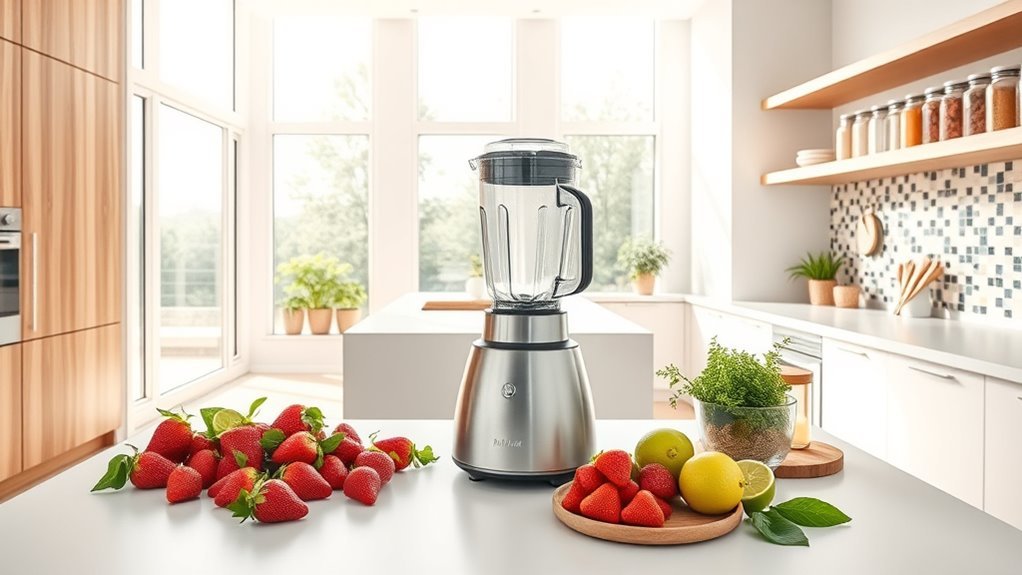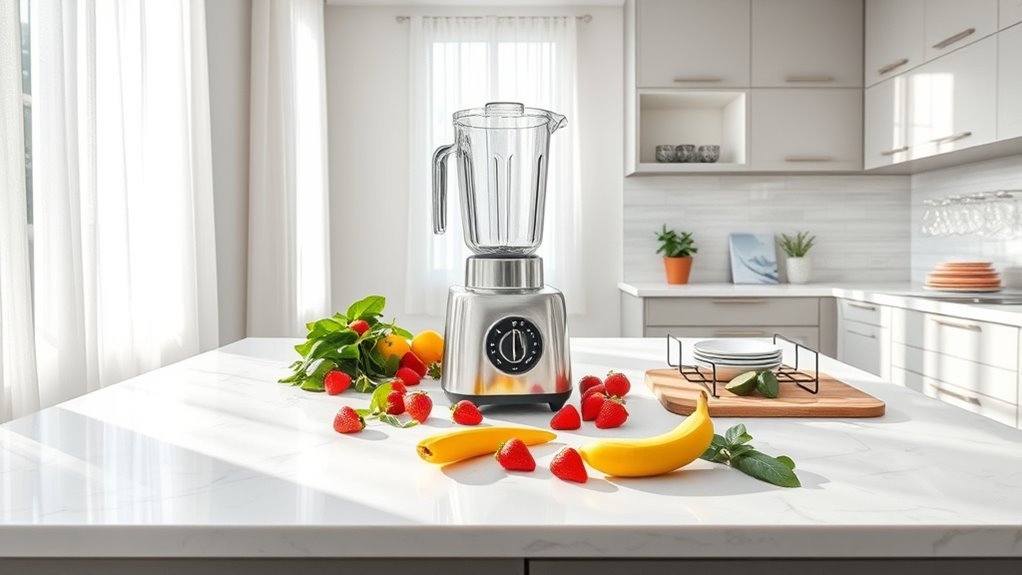We’ve identified five critical ways your blender jar’s material affects taste. Glass jars maintain flavor purity and temperature control while preventing chemical leaching. Stainless steel excels at cold retention but may add metallic notes. Plastic’s porous surface traps odors and previous flavors while leaching chemicals into your blends. Material reactivity with acidic ingredients can alter taste profiles dramatically. The right jar choice makes the difference between mediocre results and professional-grade blending.
Chemical Absorption and Flavor Transfer in Different Materials

When choosing a blender jar material, we’re not just picking something to hold our smoothies – we’re selecting a critical component that’ll directly impact taste.
Let’s break down how chemical interactions affect our blends.
Plastic jars are problematic. They absorb flavors like a sponge and can leach chemicals into your food, especially with hot or acidic ingredients. Not exactly appetizing, right?
Glass jars, however, are the gold standard for taste preservation. They’re non-reactive and won’t mess with your carefully crafted flavors. High-performance blenders often come with various speed settings that can also enhance blending efficiency and flavor integration.
Stainless steel sits somewhere in the middle – it’s generally safe but can impart a metallic taste if you’re not careful, particularly with acidic ingredients.
The key takeaway? Material matters, and if you’re serious about taste, you’ll want to think twice about that plastic container.
Temperature Retention Properties and Taste Impact
Three key factors determine how your blender’s temperature retention affects taste: thermal stability, heat conductivity, and temperature maintenance.
Let’s break down how different jar materials impact your blends:
- Glass jars excel at maintaining hot temperatures – they’re your go-to for soups and sauces that need consistent heat to preserve flavor compounds.
- Stainless steel dominates cold retention – perfect for smoothies and frozen drinks where temperature stability prevents unwanted dilution.
- Plastic jars fall short on both ends – they conduct heat poorly and can leach chemicals into hot liquids.
We’ve found that proper temperature retention isn’t just about convenience – it’s essential for taste integrity. In fact, high-performance blenders are designed to optimize blending efficiency, which further enhances flavor retention.
Glass preserves hot flavors better, while stainless steel keeps cold drinks crisp.
Don’t let plastic’s poor temperature control compromise your blend’s taste profile.
Surface Porosity Effects on Ingredient Flavors

Surface porosity stands as a critical factor in how your blender jar’s material affects ingredient flavors.
We’ve found that plastic jars, while popular, pose significant challenges due to their porous nature. Those micro-scratches and surface pores love to trap flavors from your last blend – yesterday’s garlic sauce might haunt today’s fruit smoothie.
Let’s get real about your blender container choices.
Glass and stainless steel are your non-porous materials champions here. Glass wins the flavor preservation game, keeping your blends pure and untainted. Stainless steel’s nearly there, though it might add a slight metallic tang if you slack on maintenance.
Want to prevent flavor transfer? Skip the plastic. Those microscopic pores are flavor-hoarding rebels that’ll mess with your carefully crafted recipes. Trust us – your taste buds will thank you.
Odor Retention Across Material Types
Understanding how different blender jar materials retain odors is essential for maintaining flavor integrity in your blends.
We’ve discovered that material choice dramatically impacts how flavors transfer between uses.
1. Plastic jars are notorious for odor retention – they’ll trap flavors from previous blends and release them into new recipes, especially if they’re not BPA-free.
You’ll notice them turning cloudy over time.
2. Stainless steel containers are your flavor-neutral friend.
They’re non-porous, which means no unwanted taste transfer between batches.
3. Glass jars win the taste-preservation race.
They resist staining and odor absorption, ensuring your morning smoothie won’t taste like last night’s garlic sauce.
Don’t let your blender compromise your culinary creations.
Choose materials that keep flavors pure and distinct.
Material Reactivity With Acidic and Alkaline Foods

When you’re blending acidic or alkaline ingredients, your jar material choice becomes critical for both flavor integrity and safety. We can’t stress enough how glass jars and stainless steel jars outperform plastic when blending acidic foods – they’re simply non-reactive champions.
| Material | Acidic Food Response | Flavor Impact |
|---|---|---|
| Glass | Non-reactive | None |
| Steel | Non-reactive | None |
| Plastic | Reactive | Significant |
Let’s be clear: plastic’s just asking for trouble. It leaches chemicals into your acidic blends and absorbs flavors like a sponge. We’re talking compromised taste, potential health risks, and cross-contamination between blends. Stick with glass or stainless steel – they’re your best defense against unwanted chemical reactions and flavor alterations.
Frequently Asked Questions
Are Glass Jar Blenders Safe?
We’ll find glass jars safer than plastic for blending, as they’re more durable and heat-resistant. Our glass blender jars won’t leach chemicals, providing better safety while handling both hot and cold ingredients.
Why Does Blending Wine Make It Taste Better?
Like uncorking a bottle of secrets, we’re letting wine breathe through aeration effects. When we blend, the temperature impact and flavor release mechanisms soften tannins, creating a smoother, more aromatic experience.
Is a Plastic Blender Better Than a Glass Jug?
While plastic’s durability makes it practical, we’d recommend glass for its superior heat resistance and minimal taste retention, though it’s heavier. Your choice depends on prioritizing convenience or flavor quality.
What Shouldn’t You Put in a Blender?
We shouldn’t blend whole spices, super-frozen foods, dried fruits alone, or large bones. Always guarantee proper liquid ratios, soak tough ingredients first, and avoid items that’ll damage blades or create safety hazards.

